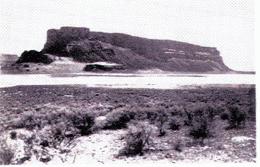On November 28, 1883, the Washington Territorial Legislature creates Douglas County. It does so by partitioning off a portion of Lincoln County.
Douglas County's boundaries were described as follows:
"Beginning at the point where the Columbia guide meridian intersects the Columbia river on the northern boundary of Lincoln county; and thence running south on said Columbia guide meridian to the township line between townships number sixteen and seventeen, thence running west on said township line to the range line between ranges twenty-seven and twenty-eight; thence south on said range line between ranges twenty-four and twenty-five in T 14 N, R 27 E; thence west on said section line to the mid-channel of the Columbia river, thence up said channel of said river to the place of beginning" (The Evolution of Washington Counties).
Lincoln County, in existence only four days before Douglas County was created out of it, had previously been part of the much larger Spokane County. The new county was named to honor politician Stephen A. Douglas (1813-1861), Abraham Lincoln's (1809-1865) opponent in the 1860 presidential race.
Between 50 and 150 settlers (non-Indians) resided in Douglas County at the time it was formed. Okanogan was the only town. This was a different Okanogan than the town of the same name in Okanogan County that became Okanogan County's seat in 1914.
An Illustrated History of the Big Bend Country, published in 1904, states that Okanogan had been platted "for the express purpose of having a place to designate as county seat. This town consisted of one tent, and the sole inhabitant was Walter Mann, who had undertaken to 'hold down' the site. There was not a store, post office, saloon, or blacksmith shop, a railway train or a stage line in the whole territory to be subsequently known as Douglas county, a territory as large as the state of Connecticut ... under what kind of spell were the Washington legislators brought that they should authorize the creation of a county containing, say, only 100 inhabitants, counting men, women, and children? The answer in three words is 'J. W. Adams' " (p. 531).
J. W. Adams
An Illustrated History called Adams "a professional town site boomer," meaning that he made his living by stirring up interest and financial investments in new or prospective towns, served as chief booster and legislative lobbyist for these communities, then (if the community was successful) reaped his profit and moved on as these towns became settled. When Adams arrived in Washington Territory, An Illustrated History continues, "the legislature which was in session appeared to him to have gone mad on county division schemes. He conceived of the idea of having a county all his own formed. He associated with him Walter Mann and H. A. Meyers under the firm name of Adams, Mann, and Company" (p. 532).
J. W. Adams, H. A. Meyers, and P. M. Corbaley were appointed county commissioners. On February 28, 1884, Meyers and Adams held the first county commissioners session in Okanogan. Still a town only in so far as it existed as name on a plat map, Okanagan boasted no shelter except Mann's tent and it was there that Meyers and Adams met. They waited for Corbaley, who never arrived, and were forced to adjourn without conducting any official business. They tried again on February 29, 1884. All three commissioners being present, Douglas County was successfully organized.
Dryville
The town of Okanogan boomed briefly after Douglas County was organized, but settlers drifted away after several attempts to dig wells yielded no water. On November 2, 1886, the majority of Douglas County voters agreed to move the county seat to Waterville. As the name suggested, Waterville had water. By 1887, the Douglas County town of Okanogan had ceased to exist. Adams, having clearly chosen the wrong town to boost, left the area in 1886.
Douglas County was reduced in size when Grant County was partitioned out of it on February 24, 1909.

